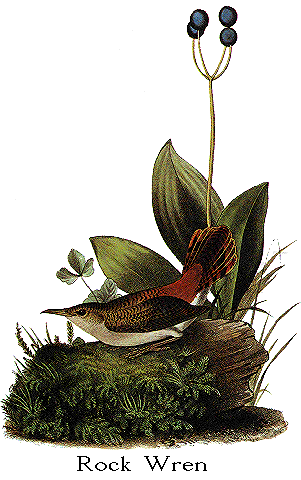Birds of America
By John James Audubon, F. R. SS. L. & E.
VOLUME II.



Family
Genus

ROCK WREN.
[Rock Wren.]
TROGLODYTES OBSOLETUS, Say.
[Salpinctes obsoletus.]

PLATE CXVI.--ADULT FEMALE.
This species was discovered by some of Major LONG's exploring party, and
first described by Mr. THOMAS SAY. My friend THOMAS NUTTALL, who had
opportunities of studying its habits, during his recent journey in company with
Mr. TOWNSEND, has assured me that they are very similar to those of the other
Wrens. The figure in the plate was taken from an adult female, given to me by
Mr. NUTTALL; and I have since then obtained two males.
"On the 21st of June," says Mr. NUTTALL, "on the ledges of the bluffs which
border the bottom of Hare's Fork of the Siskadee (or Colorado of the West), I
heard, and at length saw this curious Mountain Wren. Its actions are those of
the Carolina species, Troglodytes ludovicianus. The old female (as I supposed)
sat upon a ledge of rock at the head of a high ravine in the bluff, cocking her
tail, and balancing herself, at the same time uttering a tshurr, tshurr, and te
aigh, with a strong guttural accent, and now and then, when approached, like the
common Short-billed Marsh Wren, Troglodytes brevirostris, a quick guttural tshe
de de. It has also a shrill call at times, as it perches on a stone on the
summit of some hill, again similar to the note of the Carolina Wren,
occasionally interrupted by a tshurr. Among these arid and bare hills of the
central table-land they were quite common. The old ones were feeding and
watching a brood of four or five young, which, though fully grown, were
protected and cherished with the querulous assiduity so characteristic of the
other Wrens. They breed under the rocky ledges where we so constantly observed
them, under which they skulk at once when surprised, and pertinaciously hide in
security, like so many rats. Indeed so suddenly do they disappear among the
rocks, and remain so silent in their retreat, that it is scarcely possible to
believe them beneath your feet till after a lapse of a few minutes you begin to
hear a low cautious chirp, and the next moment) at the head of the ravine, the
old female probably again appears, scolding and jerking in the most angry
attitudes she is capable of assuming. In the same rocky retreats they are
commonly accompanied by a kind of small striped Ground Squirrel, like that of
the eastern coast in many respects, but much smaller. These little animals,
which are numerous, the White-chinned Buzzard, Buteo vulgaris of RICHARDSON and
SWAINSON, and the Raven frequently hover over and pounce upon. We met with this
species as far west as the lowest falls of the Columbia, or within a few miles
of Fort Van Couver, but among rocks and cliffs as usual."
TROGLODYTES OBSOLETA, Say, Long's Exped.
TROGLODYTES OBSOLETA, Bonap. Amer. Orn., vol. i. p. 6.
ROCKY MOUNTAIN WREN, Troglodytes obsoleta, Nutt. Man., vol. i. p. 435.
ROCK WREN, Troglodytes obsoletus, Aud. Orn. Biog., vol. iv. p. 443.
Adult Female.
Bill nearly as long as the head, slender, slightly arched, compressed
toward the end; upper mandible with the sides convex towards the end, flat and
declinate at the base, the edges sharp and overlapping, with a very slight notch
close to the declinate tip; lower mandible with the angle long and narrow, the
dorsal line very slightly concave, the sides sloping outwards and concave, the
tip narrow. Nostrils oblong, basal, with a cartilaginous operculum, open and
bare.
Head oblong; neck short; body slender. Legs of ordinary length; tarsus
longer than the middle toe, compressed, with eight anterior distinct scutella,
and two lateral plates forming a sharp edge behind. Toes of moderate size, the
third and fourth united at the base, the first large, the outer considerably
longer than the inner. Claws rather long, moderately arched, much compressed,
with an abruptly tapering, very acute tip.
Plumage soft and loose. Wings of moderate length, convex, broad and
rounded; the first quill very short, the second a quarter of an inch shorter
than the third; the fourth longest, but scarcely exceeding the third and fifth.
Tail rather long, much rounded, of twelve broad, rounded feathers.
Bill dusky, with the edges pale yellow. Iris hazel. Feet dusky. Upper
parts light dull yellowish-brown, and, excepting the rump, transversely barred
with greyish-brown; the wings barred in the same manner, excepting the
primaries, which are plain; the secondary coverts with a small white spot near
the tip. Tail-coverts barred like the back, as are the two middle tail-feathers;
the others broadly tipped with pale yellowish-red, undulated with dusky; behind
which is a broad band of brownish-black; the remaining or basal part banded like
the central feathers, the outer feather with four reddish-white spots or bars on
the outer web, the intervals being brownish-black, and a spot of white on the
inner web. The lower parts are greyish-white, tinged with sienna, the sides
inclining to yellowish-red. The lower tail-coverts are barred with
brownish-black.
Length to end of tail 6 inches, wing from flexure 2 11/12; tail 2 1/4; bill
along the ridge (9 1/2)/12; tarsus (9 1/2)/12; hind toe 4/12, its claw
(3 1/2)/12; middle toe 6/12, its claw (2 1/4)/12.
SMILACINA BOREALIS, Pursch, Flor. Amer. Sept., vol. i. p. 233.--HEXANDRIA
MONOGYNIA, Linn.
Leaves elliptico-obovate, ciliated; the scape pubescent, with a corymbose
umbel. The flowers are large, and of a greenish-yellow colour; the fruit
roundish, of a beautiful deep blue. It is extremely abundant in the dark woods
of Maine, growing in moist places.









